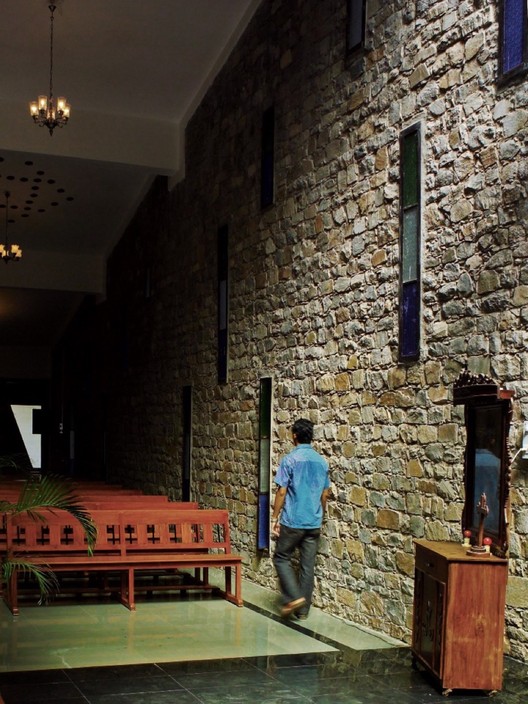
-
Architects: architecture R/T
- Area: 570 m²
- Year: 2006
-
Photographs:Harshan Thomson

Text description provided by the architects. The chapel bears no resemblance to others in the locality, yet has a deep rooted connection to its location. The building with natural stone textures blends well with the surrounding vegetation and complements the hill slope on which it abuts. The natural stone backdrop provides a divine setting, bathed in natural light, to the prayer hall. Other than the flat portion of the site where the old demolished chapel was sited, the rest of the area including the hill slope and the hill top beyond was replete with wild vegetation and teak trees that has been left more or less undisturbed.

The chapel has been built in the most environment friendly manner. For one, the entire hill slope has been conserved and the rocky hill slope integrated into the building to its advantage by using it as a key feature of its interior space. Secondly the texture of this natural edifice that forms part of the building has been left undisturbed both inside as well as outside the building.


One of the key aspects is the way in which the rocky hill slope is conserved and integrated to be a characteristic part of the design and building as a whole. The use of stone as a primary element for structural support and the adoption of vernacular load bearing system of construction are exemplary of longevity and sustainable use of stone as a building material. The large existing laterite rock that forms the backdrop to the altar of the main prayer hall is the key feature of the building and this feature is further enhanced by the use of a complimenting grey basalt stone in the main triangular profiled side walls that frame this rock face.

Product Description. Basalt stone has been used for all load bearing foundation masonry, plinth masonry and load bearing walls in the superstructure with walls reaching a height of up to 9m., also used in masonry for the entrance flight of steps and retaining wall of the adjacent building block. The colours of the basalt stone contrasts well with the laterite rock face on which the building abuts. It also blends well with the surrounding vegetation. Besides its aesthetic appeal, basalt stone is 7 times the strength of concrete and taking advantage of the fact, the entire building which scales a height to more than 9m at some places was built using this stone in load bearing system of construction.

















.jpg?1483996566)






